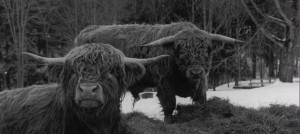Big and Rob were brought to the Mosher Farm in 2008 and they quickly won over the hearts of most whom pass by. Their unique look and personality has made them the unofficial landmark welcoming you to Killington. “Big” is a fully registered Bull and comes from the Trafalgar and Shat-Acres line of lineage. Most days they are often visited by passerby’s who stop on their way through for a short break or a picture opportunity. If you make it to the Killington Area look them up, they are in their new pasture behind our building now due to Hurricane Irene and if you take a picture send it to us and we will post it here on our page.
Highland cattle are the oldest registered breed of cattle with a Herd Book being published in 1885. The Scottish Highland Cattle Society was formed in 1884 and most of the cattle registered were black. Originally, there were two subgroups of Highland cattle, which today are merged into one. The smaller, mostly black or brindled cattle were raised on the western islands and were known as Kyloes, and the larger red animals of the Scottish mainland. Today Highland cattle may be red, black, yellow, white, brindle, silver, or dun in color. All these colors are recognized by the registry, but only solid colored animals are allowed to be shown in the sanctioned shows.
Archeological evidence of the Highland breed goes back to the 6 th century with written records existing from the 12 th century. The first recorded importation into the United States occurred in the late 1890’s when western cattlemen recognized the need to improve the hardiness of their herds. Earlier importations are likely to have occurred since large numbers of Scotch/Irish immigrants came to this country early on, but the absence of a registry precludes any definite proof. The American Highland Cattle Association registry was formed in 1948. The reasons these ranchers selected Highland Cattle are the same reasons why you should consider the breed.
Breed characteristics that make the difference include:
Hardiness and vigor: Highland cattle are noted for their hardiness and vigor. Natural selection over the centuries in the harsh climate of Scotland ensured that only the most efficient animals would survive to breed. The gene pool today remains largely intact allowing them to thrive where other breeds struggle.
Hair Coat: The double coat of hair (long, coarse, outer layer and soft wooly inner layer) is one of the most notable differences between Highlands and all other breeds. The coat reduces the need for expensive barns and shelters. It is not unusual to see Highlands grazing a day or two after a winter storm with snow still melting off their backs as they are that well insulated. The long hair over the eyes (dossan) helps reduce the incidence of pinkeye and other fly borne problems. According to one breeder, Highlands feed intake does not increase until -18 degrees F compared to 32 degrees F in many other breeds. In addition, the long hair means that the animal does not have to produce a layer of fat to stay warm. Highlands shed out earlier in the spring and produce less hair in warm climates making them suitable throughout the U.S.
Easy Handling: Highlands have a long, close history of living with humans. Early Scots would keep the cows downstairs to provide warmth for the family on the second story and to make sure the neighbors didn’t help themselves to the family’s wealth. Highlands tend to be docile and calm, do not stress easily, and are easy to work with despite their long horns. The horns are used primarily for knocking down brush to graze on, predator control and scratching. Horns on females are generally upswept and finer textured than are the males. Male horns are more forward pointing and massive.
Exceptional Mothering-Calving Ease: Highland cows are noted for being highly devoted and protective mothers. They produce a rich milk allowing for steady weight gain in the calf. Highlands are noted for calving ease. Calves are small, 40-60 pounds and birthing assists are rare. Cows may produce into their late teens reducing the need for frequent herd replacements.
Highland cows will average 900-1,200 pounds when mature. Bulls will average from 1,500 to 2,000 pounds depending on forage conditions.
